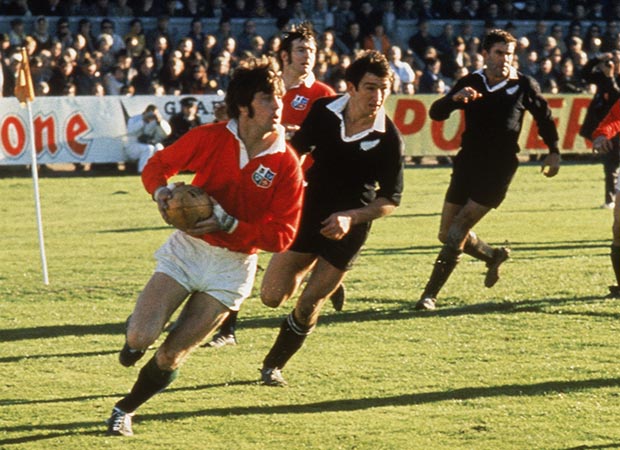
 Only those of a certain age can fully appreciate the excitement, and sheer disbelief, as news filtered back in the summer of 1971 of the Lions‘ historic triumphs in New Zealand.
Only those of a certain age can fully appreciate the excitement, and sheer disbelief, as news filtered back in the summer of 1971 of the Lions‘ historic triumphs in New Zealand.
Scarcely audible radio reports from Down Under – no clearer than the various broadcasts from the Apollo 15 moon walkers that summer – were followed by news footage ‘rushed’ back on commercial flights so that short news excerpts could be viewed on Sportsnight With Coleman in midweek.
These were followed by longer – 15 minutes – highlights on Grandstand a full week after the big event.
Our newspapers were best positioned to do the tour full justice and many fine wordsmiths went joyfully to work but to get an authentic taste of the tour now you need check out YouTube where the live NZTV coverage of all four Tests was recently posted. Wow.
Timing is everything and in many ways 1971 was the perfect storm with strong undercurrents and mighty forces merging rather than colliding. From the panache, genius and wisdom of coach Carwyn James – championed by the Lions, mistrusted by the WRU – to a once great New Zealand team beginning to lose their aura of invincibility.
It was also a triumph founded in defeat. Never had such a hungry, ambitious squad returned to the ‘scene of the crime’ so soon after their biggest ever rugby humiliation. No fewer than nine of the Lions squad – including key figures such as skipper John Dawes, JPR Williams, Gerald Davies, Gareth Edwards, Barry John and Mervyn Davies – had been pounded into submission just two years earlier when they toured New Zealand with Wales.
There was also a senior core group of others still licking their wounds from the 1966 Lions tour – Mike Gibson, Willie John McBride, Ray McLoughlin and Frank Laidlaw.
One player – Wales’ Delme Thomas – had been on both notably unsuccessful trips and was doubly fired up. The 1971 Lions were streetwise and savvy, they knew exactly what was coming their way.
The weather behaved itself – by New Zealand standards anyway – and the highly-rated Lions backs were able to let rip during their triumphant march around the provinces.
The Tests, except for the game in Christchurch, were tighter affairs with the emphasis on the Lions courageously hanging in there but occasionally you get glimpses of the Lions backs. And what backs. The 1971 Lions were uber-talented but also doggedly pragmatic. They were happy to win ugly if need be.
The emergence of John – always a genius runner and creator – as a front line kicker was pivotal. Before the Lions tour he had scored a modest 54 points in 23 Tests for Wales and that also included four tries. He was very much a part-time goal-kicker for Cardiff and Wales but on tour he suddenly consolidated his sidefooted technique and became a veritable points machine. In New Zealand he was both magician and marksman. And to think he didn’t really want to tour and didn’t answer the initial invitation and had to be chased up by a worried James.
With the goalkicking issue resolved the way was clear for the hugely physical and competitive JPR Williams – still more commonly known as John Williams back then – to write his name large at full-back, full of bristling aggression and talent. Tour manager Dr Doug Smith and James were keen that the young storm trooper, along with Gibson, add real physicality to the Lions defence behind the scrum.
Mind you Smith had to tear JPR off a strip first – the biggest rollicking of his career according to Williams – after the young medic enjoyed a big run ashore in Hong Kong where the Lions spent 24 hours en route and missed training the following morning. The Lions defeat in their first game on tour against Queensland in Brisbane a few days later has famously been attributed to jet lag – or chronic circadian dysrhythmia as Dr Smith diagnosed it to the Press – but having spoken to all manner of ’71 Lions over the years there seems little question that a heroic all-nighter in Hong Kong was the main culprit.
That defeat in Australia was also part of the perfect storm, an early reality check away from the limelight before the media descended on them on arrival in New Zealand. It also possibly sold the New Zealand rugby public an early dummy, disguising the full threat and rugby genius of their visitors for a few more precious weeks.
Not that you could keep such a secret for long. After ticking off four useful wins in the opening fortnight including a typically rugged encounter against New Zealand Maori, the Lions sent the fear of God through New Zealand observers with a spectacular 47-9 – ie 65-9 using modern scoring systems – dismantling of provincial champions Wellington in what is still considered by most as the definitive Lions performance. That was the day that Gibson was hailed as the greatest visiting back ever to play in New Zealand.
Remarkably eight of the side had been involved in that gruelling win over the Maori three days earlier. This was still the era of playing yourself fit rather than living in the gym.
“It was the best and most complete performance we ever gave, the day it all came together,” captain John Dawes recalls. “It had been building for a long time and, yes, there was a big element of pay-back involved for a lot of us.”
 On the subject of ‘payback’ New Zealand rugby bided its time a little but struck back, if that’s the right phrase, two weeks later when Canterbury ruthlessly went Lion hunting in front of 53,000 fans at Christchurch just a week before the first Test.
On the subject of ‘payback’ New Zealand rugby bided its time a little but struck back, if that’s the right phrase, two weeks later when Canterbury ruthlessly went Lion hunting in front of 53,000 fans at Christchurch just a week before the first Test.
Canterbury didn’t bag a win, in fact the result seemed of little interest to them, but they did punch and kick Ray McLoughlin and Sandy Carmichael out of the tour and rearrange most of Mick Hipwell and Fergus Slattery’s front teeth.
Coach James, having sniffed the wind, had decided at the last minute to withdraw John from the firing line and asked Gibson to move up to fly-half. They sat in the stands together and, during rare outbreaks of rugby, played particular interest in Canterbury’s highly-rated, but sometimes ponderous, full-back Fergie McCormick who was considered a certain starter for the All Blacks seven days later.
The Battle of Canterbury has gone down in infamy but only hardened the Lions resolve. McLoughlin and Carmichael had reportedly been pencilled in as the Test props but so strongly did Ian McLauchlan and Sean Lynch perform when called upon that perhaps that was an incorrect assumption.
Certainly one of the few areas of discord on the ’71 tour seems to be over this and McLauchlan has always bristled at suggestions that the departure of McLoughlin and Carmichael weakened them. McLauchlan was subsequently ever-present in all the Test matches in both the 1971 and 1974 Lions tours, a record which requires no further comment. Before the ’71 tour his nickname was Mickey, by mid tour he was Mighty.
It was also McLauchlan who charged down Alan Sutherland’s clearance kick to score the Lions solitary try in that absolutely crucial 9-3 win in the opening Test in Dunedin which was basically a Rorke’s Drift defensive effort by the Lions in which they took the very few scoring opportunities that presented themselves and then tackled as if their lives depended on it.
The All Blacks had picked six new caps and although they ruled the line-outs the Lions matched them at scrum time and, when the visitors did secure some possession, John tormented McCormick with perfectly weighted kicks into the corner.
Victory was sweet but New Zealand are usually quick learners. They reacted strongly in the second Test, upped their game in every department and decided to play at a higher tempo. The Lions, possibly expecting another monumental forward-based game, were caught unawares and although only 8-6 down at half-time quickly slipped further behind after the break.
A penalty try was awarded when Gerald Davies was adjudged to have tackled Bryan Williams without the ball, Bob Burgess crossed for a second try and then Ian Kirkpatrick scored one of the most remarkable Test tries ever by a Test forward as he set off from a maul 60 yards out and handed off various would be tacklers to score in the corner.
At 22-6 down – 32-8 in today’s terms – it was a right old drubbing but crucially the Lions rediscovered their game in the last five minutes. Gerald Davies scored his second try of the match – both world class efforts – and JPR seemed to be heading for another before he was cut down with a head high assault from Wayne Cottrell that would earn a six-month ban these days. Back then it was a simple penalty.
John also dropped a nonchalant goal just to show his mojo was undented and in the final scrum of the game the Lions shunted the All Blacks back five yards off their own ball.
Despite defeat the Lions finished that Test on a high and with the midweek team maintaining momentum, they hit the third Test running. This was the match when Edwards really showed his power and pace against a pumped-up New Zealand, matching like for like to create two first half tries, one for Gerald Davies and the second for John who converted both and added another dropped goal.
Laurie Mains scored a try but not for a minute did the Lions look like relinquishing their 13-3 half-time lead. It was quite a turnaround from the second Test but, although the Lions were guaranteed to at least draw the series, there was still work to do.
The final Test at Auckland was a nail biter with the All Blacks making a strong start with a converted try from Cottrell and a penalty by Mains but the Lions stayed level with a try from Peter Dixon and a John penalty.
Again it was nip and tuck after the break, a try for New Zealand’s Tom Lister, another John penalty before JPR, who had kicked just one dropped goal in his senior career and was never to land another, slammed one home from 45 yards with just over seven minutes left. Bob Hiller and John had randomly spent half an hour the previously afternoon honing JPR’s dropped goal technique!
Dr Smith’s pre-tour prediction of a 2-1 series win, with one draw, looked set to be wrong – gloriously so – but Mains landed a late penalty and 14-14 it was. Eat your heart out Mystic Meg.




























You must be logged in to post a comment Login